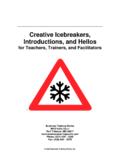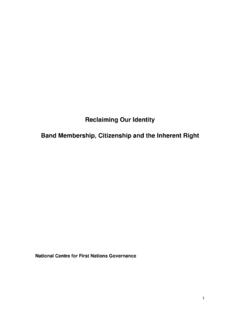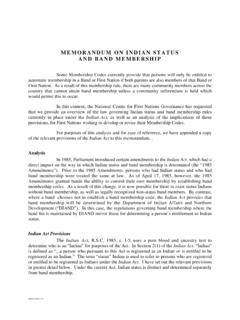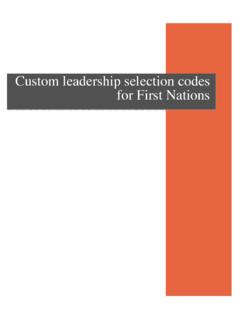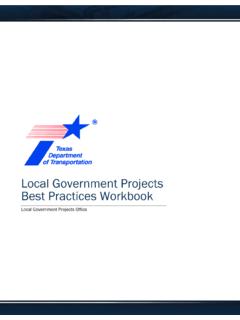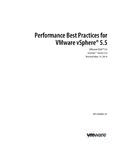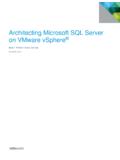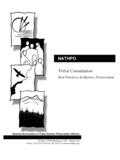Transcription of NCFNG | Governance Best Practices Report
1 National Centre for First Nations Governance Governance best Practices Report Submitted to the New Relationship Trust June 2009 Table of Contents Acknowledgments .. iiNational Centre for First Nations Governance .. iii Background to our Approach to Effective Governance .. iiiExecutive Summary .. ivGovernance Principles best Practices Table .. vIntroduction Project Vision and vi What are best Practices ? .. vi How to Use This Guide .. viGovernance Principles Governance .. vii Principles of Effective Governance .. vii Principles in Action .. vii Heirarchy of Principles .. vii best Practice Reports The People: Strategic Vision: Tsleil-Waututh First Nation.
2 1 Meaningful Information Sharing: Squiala First 3 Meaningful Information Sharing: Miawpukek First 5 Participation in Decision Making: Gila River Indian Tribe .. 7 The Land: Territorial Integrity: Haida Nation .. 9 Territorial Integrity: Yakama Nation .. 11 Economic Realization: Osoyoos Indian Band .. 13 Economic Realization: Hupacasath First Nation .. 15 Respect for the Spirit of the Land: Haisla First Nation .. 17 Respect for the Spirit of the Land: Champagne & Aishihik First Nations.
3 19 Laws & Jurisdiction: Expansion of Jurisdiction: Tsawwassen First Nation .. 21 Expansion of Jurisdiction: White Bear First Nation .. 23 Rule of Law: Nisga a Lisims Government .. 25 Institutions: Transparency and Fairness: Westbank First Nation .. 27 Results Based Organizations: First Nations & Inuit Home & Community Care .. 29 Cultural Alignment of Institutions: Teslin Tlingit Council .. 31 Cultural Alignment of Institutions: Apache Nation .. 33 Effective Inter-Governmental Relations: Sliammon First Nation.
4 35 Effective Inter-Governmental Relations: Squamish and Lil Wat First Nations .. 37 Resources: Human Resource Capacity: BC First Nations Public Service Initiative .. 39 Financial Management: Martin Aboriginal Education Initiative .. 41 Performance Evaluation: Sisseton-Wahpeton Oyate Nation .. 43 Accountability and Reporting: Membertou First Nation .. 45 Diversity of Revenue Sources: Ktunaxa Nation .. 47iiiAcknowledgments The Governance Centre wishes to thank the partners that contributed to this work:The First Nations and organizations who shared their stories.
5 The Project Steering Committee for their experience and expertise and for their generosity in sharing both: Stephen Cornell: Native Nations Institute (University of Arizona) Fred Tolmie: Nisga a Lisims Government Sophie Pierre: Ktunaxa Nation Raf DeGuevera: Westbank First Nation Herb George: National Centre for First Nations GovernanceNew Relationship Trust Corporation for financial support. NCFNG staff for research and project authors and researchers of the many sources we drew on in preparation of this work. We are grateful for their words. Any errors we made is retelling their stories are fully Centre for First Nations Governance (the Governance Centre )Our Vision Rebuild our Nations through the exercise of our inherent right to self-determination through strong, stable and culturally relevant systems of Mission Statement Support First Nations as they implement their inherent right of self-government and provide relevant and innovative knowledge and develop culturally appropriate services, products and Governance Centre has five regional offices in Canada.
6 Each regional office undertakes projects with First Nations that mirror the four business lines of our Centre. All project engagements are initiated at the invitation of the First Nation and agreements set out goals and objectives for each project. The four business lines are: Governance Advisory Services Land, Law & Governance Research Professional Development Public Education & Communication The Governance Centre is designed to assist all First Nations, no matter where they sit on the spectrum of implementing their inherent right to self-government. We work with First Nations to ensure that the traditional dimensions of First Nations experience form the basis of principles and values to guide contemporar y systems of Governance .
7 Background to Our Approach to Effective GovernanceWhile our mandate is to support First Nations to govern ourselves, the Governance Centre required a consistent approach. We returned to our strategic vision for guidance, and looked to our research most importantly, The Inherent Rights Strategy1. Next we looked to how others define Governance and more importantly effective Governance . We looked at guiding documents developed by the Native Nations Institute (in Arizona), the United Nations and the Harvard Project. We noted many similarities and important differences between these documents and drew on the best and most appropriate to move us toward our vision.
8 A big departure from other models was our prominent inclusion of principles related to the Land. While many organizational models don t naturally combine Land concepts with Governance concepts, we felt this was fundamental for us as First Nations (and for indigenous peoples worldwide). The connection between effective Governance and the Land is deep and profound. To learn more about the NCFNG , contact: Email: Toll free: 1 866 922 Framework for Aboriginal Title and Inherent Rights Strategy (the Inherent Rights Strategy ) Executive Summary The Governance best Practices Report profiles best Practices in each of the Governance Centre s seventeen principles of effective Governance .
9 The Practices are drawn from the experience of First Nations, tribes and aboriginal organizations across Canada and in the United States. Each Report profiles actual Practices being followed. These reports provide a brief snapshot of strategies, techniques, procedures or processes that produce efficiencies in Governance . They are intended to make concrete the universal principles of effective Governance by profiling their implementation in specific First Nations contexts. While the reports are intended to serve as models, each community will determine for itself how the principles are brought to life in their specific contexts.
10 The purpose of these reports is to educate First Nations and identify ways to connect with others to improve their understanding on these matters. We encourage their widespread use and give permission for them to be shared and Component Governance Principle Governance Principle In Action: best PracticesPeople Strategic Vision Tsleil-Waututh First Nation Meaningful Information Sharing Squiala First Nation Miawpukek First Nation Participation in Decision Making Gila River Indian TribeThe Land Territorial Integrity Haida Nation Yakama Nation Economic Realization Osoyoos Indian Band Hupacasath First Nation Respect for the Spirit of the Land Haisla First Nation Champagne & Aishihik First NationsLaws & Jurisdiction Expansion of Jurisdiction Tsawwassen First Nation


